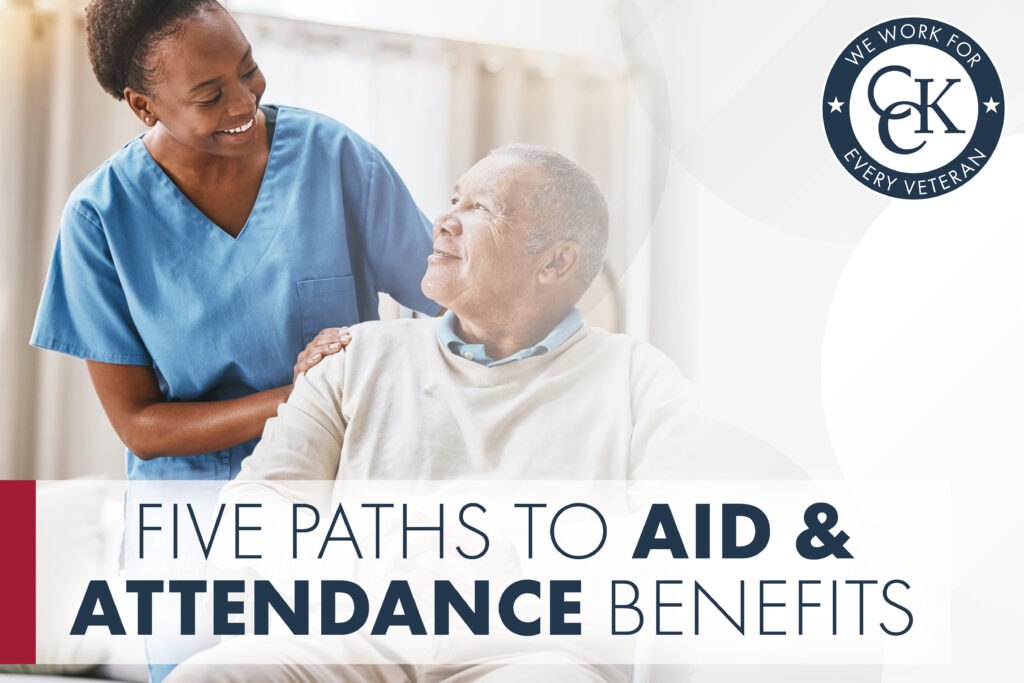Five Paths to Aid & Attendance Benefits

CCK Law: Our Vital Role in Veterans Law
Veterans Affairs (VA) Aid & Attendance (A&A) benefits can significantly improve the lives of veterans who need assistance with daily activities. A&A benefits are paid to veterans, their dependents, or survivors at rates higher than standard VA pension or VA disability compensation.
Unfortunately, there are many conflicting sources of information about Aid & Attendance requirements, assuming that veterans and their families are aware of A&A at all. This article distinguishes Special Monthly Compensation (SMC) levels L, R1, R2, T, and Enhanced Pension. As a firm that deals with many SMC cases, we will quickly highlight the unique eligibility requirements, compensation rates, and necessary forms for each program.
Aid & Attendance via Special Monthly Compensation Level L (SMC(l))

The initial tier of A&A benefits, SMC(l), supports veterans whose service-connected disabilities necessitate regular assistance with activities of daily living (ADLs). VA defines ADLs as basic self-care tasks, such as bathing, dressing, eating, using the restroom, equipping prosthetics, or managing medication.
Eligibility Requirements for SMC(l) Aid & Attendance
- The veteran must demonstrate how service-connected disabilities significantly impair their ability to perform ADLs.
- Supporting medical evidence (like a detailed physician’s note) is critical. Also useful are personal or lay statements about the veteran’s daily routine and the effects of impairment.
- VA Form 21-2680 (Examination for Housebound Status or Permanent Need for Regular Aid and Attendance) should be used to document these requirements explicitly.
VA Compensation for SMC(l) Aid & Attendance
- As of 2025, the monthly compensation rate for SMC(l) is $4,767.34 for a single veteran without dependents.
- This amount can increase based on dependents and additional qualifying conditions.
- Rates also change with federal Cost of Living Adjustments.
Aid & Attendance via Special Monthly Compensation Level R1 (SMC(r)(1))

SMC(r)(1) represents a higher tier of A&A, intended for veterans requiring more intensive care than provided under SMC(l).
Eligibility Requirements for SMC(r)(1) Aid & Attendance
- Requires a significantly higher level of care—typically continuous, around-the-clock assistance.
- Caregivers do not need to be medical professionals; spouses or family members may fulfill this role. However, documentation must illustrate the substantial level of assistance required.
VA Compensation for SMC(r)(1) Aid & Attendance
- With the 2025 Cost of Living Adjustment, monthly compensation for SMC(r)(1) is $9,559.22 per month for single veterans without dependents.
Aid & Attendance via Special Monthly Compensation Level T (SMC(t))

SMC(t) provides aid specifically to veterans who experience profound impairments due to Traumatic Brain Injury (TBI).
Eligibility Requirements for SMC(t) Aid & Attendance
- Meets SMC(r)(1) eligibility criteria but specifically due to impairments from service-connected TBI.
VA Compensation for SMC(t) Aid & Attendance
- The 2025 compensation for SMC(t) matches that of SMC(r)(2)—$10,964.66 monthly for a single veteran with no dependents—as a result of Congress’s recognition of the especially severe and unique nature of TBI-related disabilities.
Aid & Attendance via Special Monthly Compensation Level R2 (SMC(r)(2))
The highest level of SMC Aid & Attendance benefits, SMC(r)(2) addresses the needs of veterans who require professional, licensed assistance—similar to hospitalization-level care but administered at home.
Eligibility Requirements for SMC(r)(2) Aid & Attendance
- Fulfill all SMC(r)(1) criteria.
- Demonstrate a necessity for specialized care from licensed medical personnel, such as registered nurses or professional home-care providers.
- Usually, these veterans would otherwise require institutionalization if not provided with in-home care.
VA Compensation for SMC(r)(2) Aid & Attendance
- As of 2025, the monthly compensation for SMC(r)(2) ties with SMC(t) for the highest available compensation, currently $10,964.66 per month for veterans without dependents.
Aid & Attendance via Enhanced Pension (Improved Pension)
Distinct from the SMC categories above, Enhanced Pension or Improved Pension offers A&A benefits based on financial need rather than solely on service-connected disabilities. This benefit assists wartime veterans who require help with ADLs or protection from environmental hazards.
Eligibility Requirements for Enhanced Pension Aid & Attendance
- The Veteran must meet the requirements for VA pension. These include specific types of active service (wartime), age or disability criteria, and income and assets that are beneath the maximum limits.
- The Veteran cannot also be receiving SMC-based A&A benefits.
VA Compensation for Enhanced Pension Aid & Attendance
- Compensation for Enhanced Pension is notably lower than SMC Aid & Attendance, currently set at $2,358 monthly for 2025. The pension amounts are adjusted annually for inflation. Learn more on VA.gov’s pension rates page.
Getting Help With Your SMC A&A Claim or Appeal
VA-accredited veterans law advocate or attorneys, like those at Chisholm Chisholm & Kilpatrick, often have a much higher level of experience with Aid & Attendance than even many VA claims processors, which can increase the chances that veterans get the benefits to which they are entitled.
If you need assistance with your Aid & Attendance claim, or if you disagree with a VA decision related to your claim and would like to know your appeal options, please contact CCK Law for a free case evaluation.
About the Author
Share this Post
